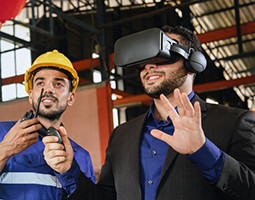July 05, 2024
Revolutionizing customer experience in the age of IoT
Connected devices are changing the way marketers, product managers and e-commerce businesses look at data. In the near future, data collected from multiple sources through IoT devices will help improve CX.
Customer loyalty is essential for businesses to retain long-term relationships with customers and to increase customer lifetime value. In fact, Gartner Research estimates that one in three businesses without a loyalty program will establish one by 2027 to increase first-party data collection and retain high-value customers.
For e-commerce companies, notably technology-driven retailers, the subscription model as applied to consumer-packaged goods (CPG), in which the retailer sends an agreed-on quantity of a product at agreed-on intervals, has helped build and retain loyal customers — but it brings its own set of challenges. Many of these could be overcome with personalization and customization enabled by the Internet of Things (IoT).
We believe that IoT will soon play a pivotal role in driving retail and warehouse engagement with the end customer by enabling an enhanced subscription model. Powered by live data collected from customers via connected devices, IoT in e-commerce will improve the sector’s ability to address issues related to inventory management and delivery. In turn, this will also help retailers craft a more compelling and engaging customer experience (CX) that drives long-term loyalty.
Subscription model challenges
The subscription model has been a boon to many retailers, but it is far from perfect; under this model, challenges that have long faced retailers still exist:
- Inventory management and fulfillment. To a certain extent, managing inventory becomes easier and more predictable with subscriptions. But under this system, fluctuations caused by fads and consumer fickleness, especially for perishable items related to dietary needs, can make it difficult and expensive to maintain inventory as consumer tastes and subscription orders change. Dead stock and slow turnover loom as particular risks.
- Delivery schedules. Delivery schedules are a key contributor to logistics cost. Under the subscription model, setting fixed times for delivery is more efficient for retailers than one-time orders. But what about better aligning deliveries to real-world consumption? What about times when the customer goes on vacation and neglects to proactively notify the retailer? As noted, consumers demand flexibility in their subscriptions; the step beyond this is proactive anticipation of changes in needs, and smart devices can help provide this.
- Data security. Subscriptions require that customers provide payment details for ongoing billing. As with e-commerce in general, such data storage comes with regulatory and security requirements. In addition, usage data must be handled appropriately while being shared internally for product insights.
Interventions supported by IoT in ecommerce can address subscription-model challenges including:
- Collecting real-time data at the point of user consumption.
- Offering greater personalization of products and subscriptions.
We believe that a similar model can improve CX in the CPG subscription arena.
Enabling subscription orders to be fulfilled based on real-time data captured through smart devices elevates the experience for customers and retail companies alike. A sensor-enabled system could offer the following features:
- Unified ecosystem. Smart devices could be operated through an app that allows users to monitor and control various parameters, such as refrigerator temperature, product usage, and their current subscription levels and frequency.
- Data insights. Research estimates that by 2025, the number of IoT connections will grow from 16 billion to 20.3 billion, with data produced reaching up to 79.4 zettabytes. Collected usage data could be analyzed by vendors to identify patterns and anticipate customer expectations to support product or service recommendations.
- Product marketplace. A connected app could be further extended to brands and e-commerce providers to extend promotional offers. For example, many retailers have implemented smart shelves to track inventory levels and make changes in real-time. Smart shelves are equipped with sensors that are connected to a central system that provides retailers with up-to-date information on product availability and stock levels, helping optimize inventory management to improve the overall shopping experience for customers.
Benefits
In addition to offering enhanced CX, peripheral benefits that emerge from connected devices include:
- Smart inventory management. With increased use of IoT-driven subscription models, inventory and delivery can be controlled easily by e-commerce companies, thanks to the live data feed on the subscribed products. In turn, usage data shared with manufacturers could be used as an input for sourcing, demand planning and inventory optimization. Moreover, retailers could change pricing strategies and create bundled offers based on usage data.
- Cross- and up-selling. Collected data could also be used to suggest complementary products or services to customers based on their usage patterns. This would help e-commerce businesses optimize their inventory across categories and product types. Typical examples would include plan upgrades based on higher-than-expected usage, or an increase in the package size of the subscribed product.
- Prototyping and promoting. The product usage data and mix would be critical inputs when designing new products, services and promotions. Thus, IoT will boost CX and result in higher satisfaction levels as retailers developed products with evidence-based features and enhanced usability. IoT devices could also be used to seek customer feedback on highly specific product features.
- Churn prediction and prevention. Artificial Intelligence (AI) is making it possible for retailers to use customer data to identify early warning signs of disengagement. Brands use data from AI to leverage predictability and take proactive measures to prevent churn by offering personalized offers to at-risk customers.
As the smart shelves example demonstrates, IoT is playing an increasingly pivotal role in driving customer loyalty. In one study, 31% of subjects who found an item out of stock at one store bought it at another. IoT can help bridge the gap to reduce friction and create a more seamless CX for guests.
We believe that IoT will improve the CPG subscription model through greater personalization and flexibility, thus increasing customer loyalty for forward-looking retailers. The challenge will be to develop IoT devices and systems that appeal to customers and can be easily integrated into their already smart home ecosystems in a secure and non-intrusive format.
Scott Headington is the North American Retail, Consumer, Travel & Hospitality Global Practices Head for Cognizant's Industry Solution Group. Scott has 25+ years of combined retail, consulting and system integration experience spanning key functional areas of retail operations.
Latest posts
Related posts
Get actionable business Insights in your inbox
Sign up for the Cognizant newsletter to gain actionable AI advice and real-world business insights delivered to your inbox every month.
















